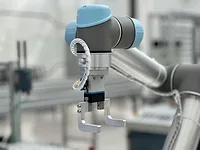ICM Dual Robot Could Change How Coatings Are Removed

ITHACA, NY – ICM has recently developed a robot for the U.S. Navy to strip coatings using heat induction technology. The robot ICM designed was essentially a dual robot, comprised of two standard ICM robots integrated to function together and thereby carry a very heavy payload. The payload being tasked on this dual robot was in the 85-pound range. In addition, the robot needed to climb over significant surface obstacles and surface irregularities.
A potential use for this robot would be to remotely remove the thick rubber-like exterior cladding from nuclear submarines when they are in dry dock for repairs or during decommissioning. Currently, this work is performed manually at great cost and danger to workers. A robot performing this mission with the human operator at a safe distance and controlling the robot with a handheld controller would save money and time, and prevent exposure to dangerous conditions. If accepted, this ICM method could revolutionize how coatings are removed from ship surfaces.
"ICM has been tracking this potential use for many years, so this is a big opportunity for us to show what we can do. We delivered the robot back in April and it has worked out very well so far, and we await more feedback from the Navy on field trials," said Samuel Maggio, President of ICM. "All indications have been very positive; the combined remote-controlled technology has done what no one else has done before," he said. "This could change everything."
Heat induction technology breaks the bond of the coating and does not require sandblasting grit, high-pressure water, abrasive discs or other high-wear items. It is clean and does not generate secondary waste.
Looking for a reprint of this article?
From high-res PDFs to custom plaques, order your copy today!







